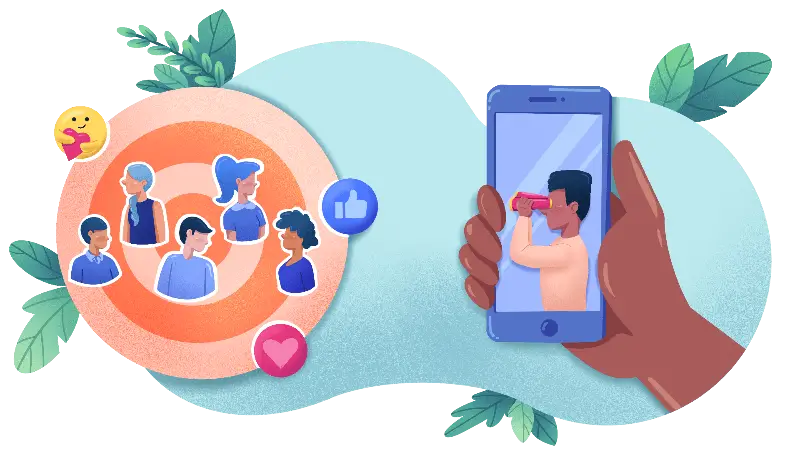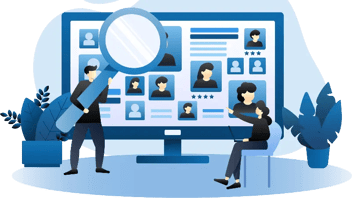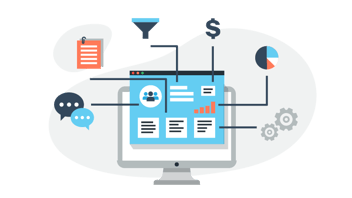How to Identify Your Ideal Customer Profile (ICP) for ABM
Precision is the name of the game in account-based marketing (ABM), and that precision starts with a crystal-clear understanding of your Ideal Customer Profile (ICP). Think of your ICP as a detailed portrait of your perfect customer–the type of company that not only benefits immensely from your product or service but also becomes a loyal advocate for your brand.
In this blog, we'll explain how to identify your ICP step-by-step so you can focus your ABM efforts on high-value accounts and maximize your marketing ROI.
What is an Ideal Customer Profile?
In account-based marketing (ABM), your Ideal Customer Profile (ICP) acts as your north star, guiding your strategy and ensuring your efforts are laser-focused. But what exactly does this profile entail? It's more than just a list of desirable traits; it's a comprehensive understanding of the companies that are the perfect fit for your business.
An ICP is a detailed description of a hypothetical company that would gain the most value from your product or service and represents the highest potential for long-term growth and profitability. It serves as a benchmark for identifying and targeting ideal accounts within your ABM strategy.
Think of your ICP as a detailed composite sketch of your dream customer. It goes beyond basic demographics and dives deep into their characteristics, motivations, and needs. This in-depth understanding allows you to tailor your marketing messages, choose the right channels, and ultimately, increase your chances of success.
Key Characteristics of an ICP:
Several key factors contribute to painting a complete picture of your ideal customer:
-
Firmographics: These are the fundamental attributes of a company, such as:
-
Industry: Which sectors are most likely to benefit from your product or service? (e.g., healthcare, finance, technology)
-
Company Size: Are you targeting startups, SMBs, or enterprise-level organizations? (e.g., employee count, annual revenue)
-
Location: Where are your ideal customers located? (e.g., specific countries, regions, or cities)
-
Revenue: What is their financial capacity, and does it align with your pricing model?
-
-
Technographics: This delves into the technology a company uses:
-
Technology Stack: What software and tools do they already employ? (e.g., CRM, marketing automation platforms)
-
Software Usage: Are they using solutions that complement or compete with yours?
-
Technological Maturity: How tech-savvy are they, and are they open to adopting new technologies?
-
-
Behavioral: This examines how companies interact with your brand and within their market:
-
Purchasing History: Have they purchased similar products or services in the past?
-
Website Engagement: How do they interact with your website? (e.g., pages visited, time spent on site)
-
Content Consumption: What type of content do they engage with? (e.g., blog posts, webinars, case studies)
-
Social Media Activity: How active are they on social media, and what platforms do they use?
-
-
Needs and Challenges: This focuses on the core reasons a company would seek your solution:
-
Pain Points: What problems are they facing that your product or service can solve?
-
Goals: What are their business objectives and aspirations?
-
Motivations: What drives their decision-making process?
-
Bringing it to Life: An Example
Let's say you're a company selling a project management software solution. Your ICP might look something like this:
-
Firmographics: Mid-sized businesses (50-250 employees) in the technology or marketing industry, located in the United States, with annual revenue between $5 million and $20 million.
-
Technographics: Currently using basic project management tools (e.g., spreadsheets, free task management apps) and open to adopting cloud-based solutions to improve collaboration and efficiency.
-
Behavioral: Actively searching for project management solutions online, downloading related ebooks, and engaging with content about team productivity and workflow optimization.
-
Needs and Challenges: Experiencing challenges with project deadlines, team communication, and resource allocation, seeking a solution to streamline workflows and improve project visibility.
By defining these characteristics, you create a blueprint for your ideal customer, enabling you to focus your ABM campaigns on companies that are most likely to convert and become long-term partners.
Why is Identifying Your ICP Crucial for ABM?
Having a well-defined ICP isn't just beneficial–it's essential. It's the foundation upon which your entire ABM strategy is built, impacting everything from targeting and messaging to resource allocation and ROI. Here's why:
Targeted Marketing
Imagine trying to hit a target with your eyes closed. That's what marketing without an ICP is like. A clearly defined ICP provides that crucial vision, allowing you to focus your marketing efforts with laser precision. You'll understand exactly who you're trying to reach, what their needs are, and where they spend their time. This enables you to craft highly targeted campaigns that resonate with your ideal customers, increasing engagement and driving conversions.
Resource Optimization
Marketing budgets are precious, and wasting them on unqualified leads is a common pitfall. A well-defined ICP helps you allocate resources efficiently by prioritizing accounts that are most likely to convert. This means less time chasing dead ends and more time nurturing relationships with high-value prospects. By concentrating your efforts on the right accounts, you maximize your marketing ROI and ensure that every dollar spent is a dollar well invested, helping you achieve ABM on a budget.
Improved ROI
It's no coincidence that companies with a strong ICP see a significant boost in their return on investment. Research shows that companies with a well-defined ICP achieve a 71% higher close rate. This is because when you target the right accounts with the right message, you're more likely to generate qualified leads, shorten sales cycles, and close more deals. A well-defined ICP sets the stage for a more efficient and effective sales and marketing process, leading to higher conversion rates and increased revenue.
Stronger Customer Relationships
ABM is about more than just closing deals; it's about building long-term relationships with your customers. By focusing on your ICP, you attract companies that are not only a good fit for your product or service but also align with your company culture and values. This leads to more meaningful and lasting customer relationships, fostering loyalty and advocacy that extends far beyond the initial sale.
How to Identify Your Ideal Customer Profile
Now that you understand the importance of an Ideal Customer Profile (ICP), let's dive into the process of actually identifying yours. This involves a combination of data analysis, market research, and a bit of detective work. But don't worry, it's not as daunting as it sounds. Here's a step-by-step guide to help you uncover your perfect customer match:
1. Analyze Your Best Existing Accounts
Your current customer base is a goldmine of information. By analyzing your best-performing customers–those who generate the most revenue, have the highest lifetime value, and are the most engaged–you can identify patterns and common traits that define your ideal customer.
How to identify top performers:
-
Revenue: Start by identifying your top 20% of customers based on revenue generated.
-
Customer Lifetime Value (CLTV): Look at customers who have consistently made purchases or renewed subscriptions over a significant period.
-
Engagement: Analyze customer engagement metrics such as website visits, content downloads, email open rates, and social media interactions.
-
Referral rate: Identify customers who frequently refer your business to others.
Hint: HubSpot offers a helpful workflow template that can streamline this process. It allows you to segment your customers based on specific criteria, such as revenue or engagement, and track their behavior over time. When you execute ABM with HubSpot, it can reveal valuable insights into the characteristics of your most valuable customers.
2. Identify Common Traits and Patterns
Once you've identified your top-performing customers, it's time to dig deeper and uncover the common threads connecting them. This involves analyzing both quantitative and qualitative data to identify patterns in firmographics, technographic, and behavioral characteristics.
Data analysis tools and techniques:
-
CRM and analytics platforms: Leverage your CRM and analytics platforms to gather data on customer demographics, purchase history, and online behavior. These will also help you measure ABM success.
-
Spreadsheets and data visualization tools: Use spreadsheets or data visualization tools to organize and analyze the data, making it easier to spot trends and patterns.
-
Customer surveys and interviews: Conduct surveys or interviews with your top customers to gain qualitative insights into their needs, challenges, and motivations.
3. Create Your ICP Framework
Now, it's time to compile all the identified traits into a comprehensive ICP framework. This framework should be a clear and concise document that outlines the key characteristics of your ideal customer.
-
Use a template or tool: Consider using a template or tool to structure your ICP framework. This can help ensure consistency and make it easier to share with your team. There are many free templates available online, or you can create your own using a simple spreadsheet or document.
-
Document your ICP: It's crucial to document your ICP and make it accessible to your sales and marketing teams. This ensures everyone is on the same page and working towards the same goals.
4. Refine and Update Your ICP
Your ICP is not static; it should evolve as your business grows and the market changes. Regularly review and update your ICP based on new data, feedback from your sales and marketing teams, and market research.
-
Gather feedback: Encourage your sales and marketing teams to provide feedback on the accuracy and effectiveness of your ICP. They are on the front lines and have valuable insights into the types of customers who are most likely to convert and become long-term partners.
-
Market research and competitive analysis: Stay informed about market trends and your competitors' activity. This can help you identify new potential customer segments or adjust your ICP to reflect changes in the market.
By following these steps and regularly refining your ICP, you can ensure that your ABM campaigns are always targeting the right accounts, maximizing your marketing ROI, and driving sustainable business growth.
How to Use Your ICP in ABM Campaigns
Defining your Ideal Customer Profile (ICP) is a crucial first step, but the real magic happens when you actively utilize it to shape your ABM campaigns. Here's how to translate your ICP insights into targeted and effective marketing actions:
Targeted Account Selection
Your ICP provides the blueprint for identifying and prioritizing your target accounts. Use the defined characteristics to filter your prospect list and focus on companies that closely match your ideal customer. Leverage data providers, LinkedIn Sales Navigator, and your CRM to pinpoint companies that align with your ICP's firmographics, technographics, and behavioral traits. This ensures your efforts are directed towards accounts with the highest potential for conversion and long-term value.
Personalized Messaging
Generic messaging rarely resonates with high-value accounts. Your ICP allows you to personalize your outreach and tailor your messaging to the specific needs and challenges of your target audience. Craft compelling narratives that address their pain points, demonstrate a deep understanding of their industry, and showcase how your solution can help them achieve their goals. This level of personalization increases engagement and builds trust, paving the way for meaningful conversations.
Channel Optimization
Not all channels are created equal. Your ICP can guide you towards the platforms and channels where your ideal customers are most active. If your ICP suggests they are heavily engaged on LinkedIn, prioritize your efforts there. If they frequently attend industry events, consider sponsoring or exhibiting at those events. By aligning your channel strategy with your ICP's preferences, you maximize your reach and ensure your message is seen by the right audience.
Content Customization
Content marketing is only effective when it's relevant to your audience. Use your ICP insights to create content that addresses the specific needs and challenges of your ideal customers. Develop case studies featuring similar companies, create webinars on topics relevant to their industry, and tailor your website content to their interests. This customized content demonstrates your expertise and commitment to their success, positioning you as a valuable partner.
By weaving your ICP into every facet of your ABM campaigns–from account selection to content creation–you can achieve greater precision, personalization, and, ultimately, a higher return on your marketing investment.
Unlock ABM Success Today
Defining your ICP is a game-changer for any business looking to leverage the power of account-based marketing. By analyzing your best customers, identifying common traits, and creating a structured framework, you can pinpoint your ideal audience and tailor your marketing efforts accordingly.
Remember, your ICP is a dynamic entity that requires continuous refinement and adaptation. Stay informed about market trends, gather feedback from your sales and marketing teams, and be prepared to adjust your strategy as needed.
Ready to take your HubSpot ABM strategy to the next level? Aspiration Marketing can help. Our team of experts can guide you through the process of ICP development and ABM implementation, providing the tools and strategies you need to achieve your marketing goals.
Contact us today for a free consultation and discover how we can help you unlock the full potential of ABM.
This content is also available in:
- German: Wie Sie Ihr ideales Kundenprofil (ICP) für ABM identifizieren
- Spanish: Cómo identificar su perfil de cliente ideal (ICP) para ABM
- French: Comment identifier votre profil de client idéal (PCI) pour l'ABM
- Italian: Come identificare il profilo del cliente ideale (ICP) per l'ABM
- Romanian: Cum să vă identificați profilul clientului ideal (ICP) pentru ABM
- Chinese: 如何为 ABM 确定理想客户档案 (ICP)










Leave a Comment